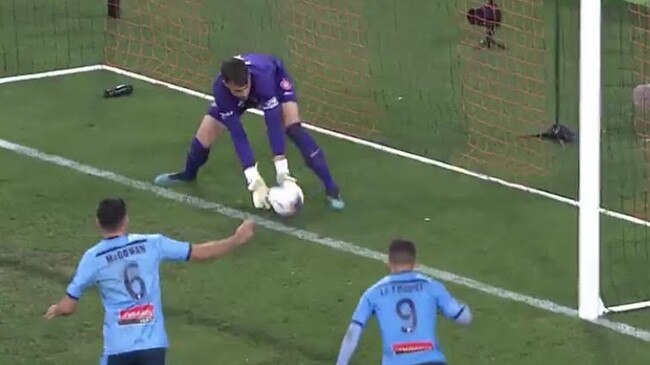Sydney FC left fuming after derby loss but expensive goalline technology not on horizon for A-League
Sydney FC’s claims they had an equalising goal in the derby unfairly not given are unlikely to result in technology being upgraded in the A-League, because of the money it would involve.

A-League
Don't miss out on the headlines from A-League. Followed categories will be added to My News.
It was the moment that summed up the derby — a lucky escape for the Wanderers, a fractional near miss for Sydney FC, and the fans left gloating or fuming depending on the colours they wear.
But Sydney FC’s claims they had an equalising goal in the derby unfairly not given are very unlikely to result in goalline technology being implemented by the A-League, because of the millions of dollars it would cost to implement.
Western Sydney rode their luck to claim a 1-0 win in the first derby of the season, never more so than when Sydney FC striker Kosta Barbarouses thought he’d scored with a header from Brandon O’Neill’s corner in the second half.
Stream every game of The 2019/20 Hyundai A-League season LIVE & On-Demand with KAYO SPORTS. Get your 14 day free trial & start streaming instantly >

When Barbarouses’s header hit the inside of the post and spun along the goalline, it could have gone in. It’s possible it did go in, before Wanderers goalkeeper Daniel Lopar gratefully grabbed the ball and wagged a finger at the referee to persuade him it hadn’t actually crossed the line.
But the linesman didn’t think it had, referee Alireza Faghani didn’t, and VAR Craig Zetter had no angle conclusive enough to overrule them and give a goal.
Unlike a handful of the world’s richest competitions, the A-League doesn’t have goalline technology, of the sort that tells EPL refs in one second if the whole of the ball has crossed the line and they should award a goal.
Like America’s MLS, the sheer cost versus the number of match-changing moments it would affect mean A-League officials have long argued it’s money that could be better spent elsewhere.
The HawkEye system most widely used costs close to $500,000 per stadium to install, because five cameras are required in each goal to provide the angles necessary for HawkEye’s software to compute the position of the ball.
In the A-League that cost would be multiplied for teams which play in more than one venue — that’s seven of the 11 clubs this season.

But even just installing it once per club would cost 37 times as much as the $150,000 investment the A-League made this season in another piece of HawkEye technology, to rule on microscopically close offsides.
“In reality the implementation of technology is a staged approach, given its cost,” A-League boss Greg O’Rourke said.
“Our primary concern from previous seasons was the number of close offside calls and our next investment was to address this (with the HawkEye offside line) — and we feel we have been successful in bringing this technology to the League this year.
“We will continue to review the next stages.”
In most cases cited as examples of when GLT would be used, the VAR can make a definitive ruling based on normal camera angles.
In 2016, Melbourne Victory midfielder Gui Finkler was denied a goal when his free kick hit the bar in the Melbourne derby, bounced down over the line and spun out again. The VAR would have awarded a goal there in seconds.

After Saturday night’s Sydney derby, Sky Blues coach Steve Corica claimed Barbarouses’s effort should have been given from the replay he saw on the big screen in the stadium.
"I thought it was over the line, from where I am,” he said.
“It's a little bit frustrating when you do see that, especially on the big screen. It's clear.”
A still of the ball’s position just before Lopar grabbed it was widely distributed on social media by Sydney fans backing that view, but Fox Sports pundit Robbie Slater showed after the game how from a particular angle the ball can appear over the line when part of it is not.
Not surprisingly, Wanderers boss Markus Babbel agreed with that.
“In my eyes the ball was not over the line, not all of it,” he said.

“It was the right decision, not because it was against me, I also would say it if it was against Sydney FC.
“At the moment, to be fair, the referees and the VAR are doing a fantastic job and every decision is right.”
That included Faghani’s decision — upheld by the VAR — not to give Sydney a penalty when the ball struck the arm of Wanderers midfielder Keanu Baccus in his own penalty area before being cleared.
Corica was fuming over that, too.
“It was a definite penalty,” he said.
“There was one of our players right behind him that would have tapped it in.”
But under the strict letter of FIFA’s changes to the law on handballs this season, it wasn’t a clear penalty. Baccus’s arm was tight against his body as he ran towards the cross.
FIFA’s guidance to referees states that it’s not handball where “the ball touches a player's hand/arm which is close to their body and has not made their body unnaturally bigger”.
